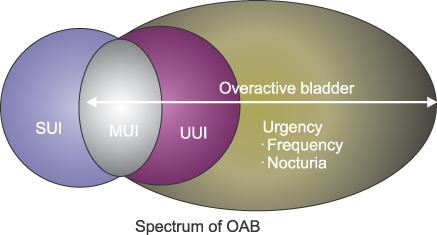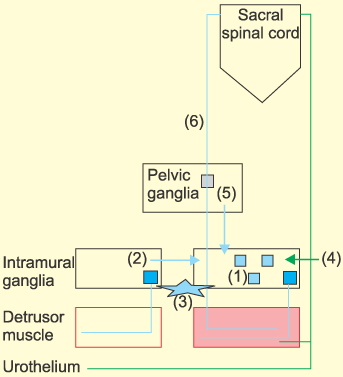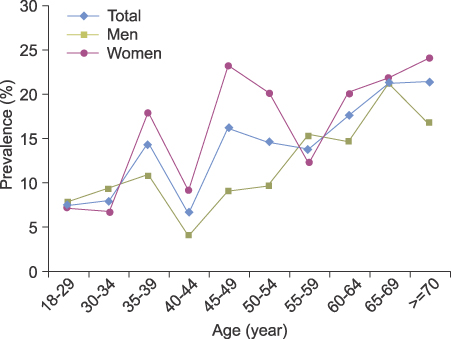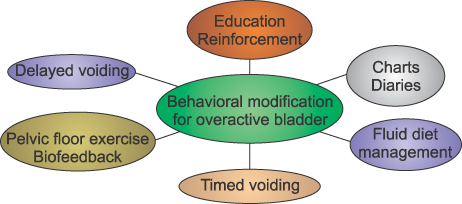Korean J Urol.
2007 Dec;48(12):1191-1208. 10.4111/kju.2007.48.12.1191.
Overactive Bladder
- Affiliations
-
- 1Department of Urology, Sungkyunkwan University School of Medicine, Seoul, Korea. ksleedr@skku.edu
- KMID: 1990140
- DOI: http://doi.org/10.4111/kju.2007.48.12.1191
Abstract
- Overactive bladder(OAB) is a symptom syndrome including urinary urgency with or without urinary incontinence, usually with frequency and nocturia. Urgency, defined as the compelling feeling of impending incontinence that is difficult to defer, is the cornerstone symptom of OAB. The diagnosis is based on symptoms alone and assumes no underlying pathology. Approximately 12.2% of the adult population experience OAB in Korea. The syndrome is now recognized as a chronic debilitating condition that negatively affects the quality of life. Often the patients have a restricted social life and an increased risk for depression. Despite increased awareness in recent years, OAB remains an underreported condition. Continued evolution of our understanding of the pathophysiology of OAB has identified contributory mechanisms, which has in turn established structured evidence-based managements. Treatment of OAB is aimed at relief of symptoms and improving quality of life. Conservative treatments combined with antimuscarinic drugs are the main treatment for OAB. There are many antimuscarinics available, with several under development, which have different specificities for the muscarinic receptors. Other drugs have also been tried but with limited success. Behavioral therapy combined with pharmacological therapy often will bring about acceptable outcomes for patients with OAB. Modalities such as botulinum toxin injections, neuromodulation, and various surgical interventions also are showing encouraging results in more refractory patients. Further research into the basic science of the condition is required to identify the true cause of OAB, allowing new targeted treatments to be established.
Keyword
MeSH Terms
Figure
Reference
-
1. Abrams P, Cardozo L, Fall M, Griffiths D, Rosier P, Ulmsten U, et al. The standardisation of terminology of lower urinary tract function: report from the Standardisation Sub-committee of the International Continence Society. Neurourol Urodyn. 2002. 21:167–178.2. Hashim H, Abrams P. Is the bladder a reliable witness for predicting detrusor overactivity? J Urol. 2006. 175:191–194.3. Abrams P, Cardozo L, Fall M, Griffiths D, Rosier P, Ulmsten U, et al. The standardisation of terminology of lower urinary tract function: report from the Standardisation Sub-committee of the International Continence Society. Neurourol Urodyn. 2002. 21:167–178.4. Brading AF. A myogenic basis for the overactive bladder. Urology. 1997. 50:57–67.5. Elbadawi A, Yalla SV, Resnick NM. Structural basis of geriatric voiding dysfunction. IV. Bladder outlet obstruction. J Urol. 1993. 150:1681–1695.6. Elbadawi A, Yalla SV, Resnick NM. Structural basis of geriatric voiding dysfunction. III. Detrusor overactivity. J Urol. 1993. 150:1668–1680.7. de Groat WC. A neurologic basis for the overactive bladder. Urology. 1997. 50(6A):Suppl. 36–52.8. Drake MJ, Mills IW, Gillespie JI. Model of peripheral autonomous modules and a myovesical plexus in normal and overactive bladder function. Lancet. 2001. 358:401–403.9. Zorn BH, Montgomery H, Pieper K, Gray M, Steers WD. Urinary incontinence and depression. J Urol. 1999. 162:82–84.10. Stewart WF, Van Rooyen JB, Cundiff GW, Abrams P, Herzog AR, Corey R, et al. Prevalence and burden of overactive bladder in the United States. World J Urol. 2003. 20:327–336.11. Melville JL, Katon W, Lentz G, Miller J, Fenner D. Prevalence of comorbid psychiatric illness and its impact on symptom perception, quality of life, and functional status in women with urinary incontinence. Am J Obstet Gynecol. 2002. 187:80–87.12. Lee KS, Na YG, Dean-McKinney T, Klausner AP, Tuttle JB, Steers WD. Alterations in voiding frequency and cystometry in the clomipramine induced model of endogenous depression and reversal with fluoxetine. J Urol. 2003. 170:2067–2071.13. Ouslander JG. Management of overactive bladder. N Engl J Med. 2004. 350:786–799.14. Milsom I, Abrams P, Cardozo L, Roberts RG, Thuroff J, Wein AJ. How widespread are the symptoms of an overactive bladder and how are they managed? A population-based prevalence study. BJU Int. 2001. 87:760–766.15. Irwin DE, Milsom I, Hunskaar S, Reilly K, Kopp Z, Herschorn S, et al. Population-based survey of urinary incontinence, overactive bladder, and other lower urinary tract symptoms in five countries: results of the EPIC study. Eur Urol. 2006. 50:1306–1314.16. Komaroff AL, Fagioli LR, Doolittle TH, Gandek B, Gleit MA, Guerriero RT, et al. Health status in patients with chronic fatigue syndrome and in general population and disease comparison groups. Am J Med. 1996. 101:281–290.17. Kelleher CJ, Reese PR, Pleil AM, Okano GJ. Health-related quality of life of patients receiving extended-release tolterodine for overactive bladder. Am J Manag Care. 2002. 8(19):Suppl. S608–S615.18. Liberman JN, Hunt TL, Stewart WF, Wein A, Zhou Z, Herzog AR, et al. Health-related quality of life among adults with symptoms of overactive bladder: results from a U.S. community-based survey. Urology. 2001. 57:1044–1050.19. Kobelt G. Economic considerations and outcome measurement in urge incontinence. Urology. 1997. 50(6A):Suppl. 100–107.20. Brown JS, Posner SF, Stewart AL. Urge incontinence: new health-related quality of life measures. J Am Geriatr Soc. 1999. 47:980–988.21. DuBeau CE, Kiely DK, Resnick NM. Quality of life impact of urge incontinence in older persons: a new measure and conceptual structure. J Am Geriatr Soc. 1999. 47:989–994.22. Dugan E, Cohen SJ, Bland DR, Preisser JS, Davis CC, Suggs PK, et al. The association of depressive symptoms and urinary incontinence among older adults. J Am Geriatr Soc. 2000. 48:413–416.23. Steers WD, Lee KS. Depression and incontinence. World J Urol. 2001. 19:351–357.24. Brown JS, Vittinghoff E, Wyman JF, Stone KL, Nevitt MC, Ensrud KE, et al. Urinary incontinence: does it increase risk for falls and fractures? Study of Osteoporotic Fractures Research Group. J Am Geriatr Soc. 2000. 48:721–725.25. Dmochowski RR, Sanders SW, Appell RA, Nitti VW, Davila GW. Bladder-health diaries: an assessment of 3-day vs 7-day entries. BJU Int. 2005. 96:1049–1054.26. Marks LS, Dorey FJ, Macairan ML, Park C, deKernion JB. Three-dimensional ultrasound device for rapid determination of bladder volume. Urology. 1997. 50:341–348.27. Gormley EA, Griffiths DJ, McCracken PN, Harrison GM, McPhee MS. Effect of transurethral resection of the prostate on detrusor instability and urge incontinence in elderly males. Neurourol Urodyn. 1993. 12:445–453.28. Nitti VW, Raz S. Obstruction following anti-incontinence procedures: diagnosis and treatment with transvaginal urethrolysis. J Urol. 1994. 152:93–98.29. Goode PS. Behavioral and drug therapy for urinary incontinence. Urology. 2004. 63(3):Suppl 1. 58–64.30. Song C, Park JT, Heo KO, Lee KS, Choo MS. Effects of bladder training and/or tolterodine in female patients with overactive bladder syndrome: a prospective, randomized study. J Korean Med Sci. 2006. 21:1060–1063.31. Fantl JA, Wyman JF, McClish DK, Harkins SW, Elswick RK, Taylor JR, et al. Efficacy of bladder training in older women with urinary incontinence. JAMA. 1991. 265:609–613.32. Burgio KL, Goode PS, Locher JL, Umlauf MG, Roth DL, Richter HE, et al. Behavioral training with and without biofeedback in the treatment of urge incontinence in older women: a randomized controlled trial. JAMA. 2002. 288:2293–2299.33. Burgio KL, Locher JL, Goode PS, Hardin JM, McDowell BJ, Dombrowski M, et al. Behavioral vs drug treatment for urge urinary incontinence in older women: a randomized controlled trial. JAMA. 1998. 280:1995–2000.34. Jarvis GJ, Millar DR. Controlled trial of bladder drill for detrusor instability. Br Med J. 1980. 281:1322–1323.35. Andersson KE. Bladder activation: afferent mechanisms. Urology. 2002. 59(5):Suppl 1. 43–50.36. Yoshida M, Inadome A, Murakami S, Miyamae K, Iwashita H, Otani M, et al. Effects of age and muscle stretching on acetylcholine release in isolated human bladder smooth muscle. J Urol. 2002. 167:40. [abstract 160].37. Diokno AC, Appell RA, Sand PK, Dmochowski RR, Gburek BM, Klimberg IW, et al. Prospective, randomized, double-blind study of the efficacy and tolerability of the extended-release formulations of oxybutynin and tolterodine for overactive bladder: results of the OPERA trial. Mayo Clin Proc. 2003. 78:687–695.38. Van Kerrebroeck P, Kreder K, Jonas U, Zinner N, Wein A. Tolterodine once-daily: superior efficacy and tolerability in the treatment of the overactive bladder. Urology. 2001. 57:414–421.39. Wiedemann A, Fusgen I, Hauri D. New aspects of therapy with trospium chloride for urge incontinence. Eur J Geriatrics. 2002. 3:41.40. Rovner ES. Trospium chloride in the management of overactive bladder. Drugs. 2004. 64:2433–2446.41. Haab F, Stewart L, Dwyer P. Darifenacin, an M3 selective receptor antagonist, is an effective and well-tolerated once-daily treatment for overactive bladder. Eur Urol. 2004. 45:420–429.42. Chapple CR. Darifenacin: a novel M3 muscarinic selective receptor antagonist for the treatment of overactive bladder. Expert Opin Investig Drugs. 2004. 13:1493–1500.43. Chapple C, Dubeau C, Ebinger U, Rekeda L, Viegas A. Darifenacin treatment of patients >/=65 years with overactive bladder: results of a randomized, controlled, 12-week trial. Curr Med Res Opin. 2007. 23:2347–2358.44. Smith CM, Wallis RM. Characterisation of [3H]-darifenacin as a novel radioligand for the study of muscarinic M3 receptors. J Recept Signal Transduct Res. 1997. 17:177–184.45. Chapple CR, Arano P, Bosch JL, De Ridder D, Kramer AE, Ridder AM. Solifenacin appears effective and well tolerated in patients with symptomatic idiopathic detrusor overactivity in a placebo- and tolterodine-controlled phase 2 dose-finding study. BJU Int. 2004. 93:71–77.46. Chapple CR, Martinez-Garcia R, Selvaggi L, Toozs-Hobson P, Warnack W, Drogendijk T, et al. A comparison of the efficacy and tolerability of solifenacin succinate and extended release tolterodine at treating overactive bladder syndrome: results of the STAR trial. Eur Urol. 2005. 48:464–470.47. Ekstrom B, Andersson KE, Mattiasson A. Urodynamic effects of intravesical instillation of atropine and phentolamine in patients with detrusor hyperactivity. J Urol. 1993. 149:155–158.48. Enskat R, Deaney CN, Glickman S. Systemic effects of intravesical atropine sulphate. BJU Int. 2001. 87:613–616.49. Lose G, Nørgaard JP. Intravesical oxybutynin for treating incontinence resulting from an overactive detrusor. BJU Int. 2001. 87:767–773.50. Kasabian NG, Vlachiotis JD, Lais A, Klumpp B, Kelly MD, Siroky MB, et al. The use of intravesical oxybutynin chloride in patients with detrusor hypertonicity and detrusor hyperreflexia. J Urol. 1994. 151:944–945.51. Palmer LS, Zebold K, Firlit CF, Kaplan WE. Complications of intravesical oxybutynin chloride therapy in the pediatric myelomeningocele population. J Urol. 1997. 157:638–640.52. Appell RA, Chancellor MB, Zobrist RH, Thomas H, Sanders SW. Pharmacokinetics, metabolism, and saliva output during transdermal and extended-release oral oxybutynin administration in healthy subjects. Mayo Clin Proc. 2003. 78:696–702.53. Chancellor MB, Appell RA, Sathyan G, Gupta SK. A comparison of the effects on saliva output of oxybutynin chloride and tolterodine tartrate. Clin Ther. 2001. 23:753–760.54. Dmochowski RR, Sand PK, Zinner NR, Gittelman MC, Davila GW, Sanders SW. Comparative efficacy and safety of transdermal oxybutynin and oral tolterodine versus placebo in previously treated patients with urge and mixed urinary incontinence. Urology. 2003. 62:237–242.55. Dmochowski RR, Davila GW, Zinner NR, Gittelman MC, Saltzstein DR, Lyttle S, et al. Efficacy and safety of transdermal oxybutynin in patients with urge and mixed urinary incontinence. J Urol. 2002. 168:580–586.56. Haruno A. Inhibitory effects of propiverine hydrochloride on the agonist-induced or spontaneous contractions of various isolated muscle preparations. Arzneimittelforschung. 1992. 42:815–817.57. Tokuno H, Chowdhury JU, Tomita T. Inhibitory effects of propiverine on rat and guinea-pig urinary bladder muscle. Naunyn Schmiedebergs Arch Pharmacol. 1993. 348:659–662.58. Dorschner W, Stolzenburg JU, Griebenow R, Halaska M, Schubert G, Murtz G, et al. Efficacy and cardiac safety of propiverine in elderly patients - a double-blind, placebo-controlled clinical study. Eur Urol. 2000. 37:702–708.59. Oka M, Kimura Y, Itoh Y, Sasaki Y, Taniguchi N, Ukai Y, et al. Brain pertussis toxin-sensitive G proteins are involved in the flavoxate hydrochloride-induced suppression of the micturition reflex in rats. Brain Res. 1996. 727:91–98.60. Chapple C, Khullar V, Gabriel Z, Dooley JA. The effects of antimuscarinic treatments in overactive bladder: a systematic review and meta-analysis. Eur Urol. 2005. 48:5–26.61. Choo MS, Song C, Kim JH, Choi JB, Lee JY, Chung BS, et al. Changes in overactive bladder symptoms after discontinuation of successful 3-month treatment with an antimuscarinic agent: a prospective trial. J Urol. 2005. 174:201–204.62. Maggi CA, Borsini F, Lecci A, Giuliani S, Meli P, Gragnani L, et al. Effect of acute or chronic administration of imipramine on spinal and supraspinal micturition reflexes in rats. J Pharmacol Exp Ther. 1989. 248:278–285.63. Glazener CM, Evans JH, Peto RE. Tricyclic and related drugs for nocturnal enuresis in children. Cochrane Database Syst Rev. 2003. CD002117.64. Giardina EG, Bigger JT Jr, Glassman AH, Perel JM, Kantor SJ. The electrocardiographic and antiarrhythmic effects of imipramine hydrochloride at therapeutic plasma concentrations. Circulation. 1979. 60:1045–1052.65. Castleden CM, Duffin HM, Gulati RS. Double-blind study of imipramine and placebo for incontinence due to bladder instability. Age Ageing. 1986. 15:299–303.66. Hunsballe JM, Djurhuus JC. Clinical options for imipramine in the management of urinary incontinence. Urol Res. 2001. 29:118–125.67. Darblade B, Behr-Roussel D, Oger S, Hieble JP, Lebret T, Gorny D, et al. Effects of potassium channel modulators on human detrusor smooth muscle myogenic phasic contractile activity: potential therapeutic targets for overactive bladder. Urology. 2006. 68:442–448.68. Tertyshnikova S, Knox RJ, Plym MJ, Thalody G, Griffin C, Neelands T, et al. BL-1249 [ (5,6,7,8-tetrahydro-naphthalen-1-yl)-[2-(1H-tetrazol-5-yl)-phenyl]-amine]: a putative potassium channel opener with bladder-relaxant properties. J Pharmacol Exp Ther. 2005. 313:250–259.69. Schwinn DA, Price PR. Molecular pharmacology of human a1-adrenergic receptors: unique features of the a1-subtype. Eur Urol. 1999. 36:Suppl 1. 7–10.70. Ohtake A, Ukai M, Saitoh C, Sonoda R, Noguchi Y, Okutsu H, et al. Effect of tamsulosin on spontaneous bladder contraction in conscious rats with bladder outlet obstruction: comparison with effect on intraurethral pressure. Eur J Pharmacol. 2006. 545:185–191.71. Tatemichi S, Akiyama K, Kobayashi M, Yamazaki Y, Yokoyama O, Uruno T. A selective alpha1A-adrenoceptor antagonist inhibits detrusor overactivity in a rat model of benign prostatic hyperplasia. J Urol. 2006. 176:1236–1241.72. Trevisani M, Campi B, Gatti R, Andre E, Materazzi S, Nicoletti P, et al. The influence of alpha1-adrenoreceptors on neuropeptide release from primary sensory neurons of the lower urinary tract. Eur Urol. 2007. 52:901–908.73. Yokoyama O, Yusup A, Oyama N, Aoki Y, Miwa Y, Akino H. Improvement in bladder storage function by tamsulosin depends on suppression of C-fiber urethral afferent activity in rats. J Urol. 2007. 177:771–775.74. Yamanishi T, Yasuda K, Kitahara S, Nakai H, Yoshida K, Iizuka H. Effects of 138-355, a beta3-adrenoceptor selective agonist, on relaxation of the human detrusor muscle in vitro. Neurourol Urodyn. 2006. 25:815–819.75. Biers SM, Reynard JM, Brading AF. The effects of a new selective beta3-adrenoceptor agonist (GW427353) on spontaneous activity and detrusor relaxation in human bladder. BJU Int. 2006. 98:1310–1314.76. Murakami S, Chapple CR, Akino H, Sellers DJ, Chess-Williams R. The role of the urothelium in mediating bladder responses to isoprenaline. BJU Int. 2007. 99:669–673.77. Green SA, Alon A, Ianus J, McNaughton KS, Tozzi CA, Reiss TF. Efficacy and safety of a neurokinin-1 receptor antagonist in postmenopausal women with overactive bladder with urge urinary incontinence. J Urol. 2006. 176:2535–2540.78. Cardozo LD, Stanton SL, Robinson H, Hole D. Evaluation of flurbiprofen in detrusor instability. Br Med J. 1980. 280:281–282.79. Palmer J. Report of a double-blind crossover study of flurbiprofen and placebo in detrusor instability. J Int Med Res. 1983. 11:Suppl 2. 11–17.80. Liu L, Mansfield KJ, Kristiana I, Vaux KJ, Millard RJ, Burcher E. The molecular basis of urgency: regional difference of vanilloid receptor expression in the human urinary bladder. Neurourol Urodyn. 2007. 26:433–438.81. Ishizuka O, Mattiasson A, Andersson KE. Urodynamic effects of intravesical resiniferatoxin and capsaicin in conscious rats with and without outflow obstruction. J Urol. 1995. 154:611–616.82. Kuo HC, Liu HT, Yang WC. Therapeutic effect of multiple resiniferatoxin intravesical instillations in patients with refractory detrusor overactivity: a randomized, double-blind, placebo controlled study. J Urol. 2006. 176:641–645.83. Apostolidis A, Gonzales GE, Fowler CJ. Effect of intravesical Resiniferatoxin (RTX) on lower urinary tract symptoms, urodynamic parameters, and quality of life of patients with urodynamic increased bladder sensation. Eur Urol. 2006. 50:1299–1305.84. Andrade EL, Ferreira J, Andre E, Calixto JB. Contractile mechanisms coupled to TRPA1 receptor activation in rat urinary bladder. Biochem Pharmacol. 2006. 72:104–114.85. Dmochowski RR. Duloxetine: a summary of published clinical experience. Rev Urol. 2004. 6:Suppl 3. S56–S63.86. de Miguel F, Chancellor MB. [Pittsburgh experience with botulinum toxin A injection]. Actas Urol Esp. 2006. 30:310–314.87. Karsenty G, Reitz A, Lindemann G, Boy S, Schurch B. Persistence of therapeutic effect after repeated injections of botulinum toxin type A to treat incontinence due to neurogenic detrusor overactivity. Urology. 2006. 68:1193–1197.88. Lucioni A, Rapp DE, Gong EM, Fedunok P, Bales GT. Intravesical botulinum type A toxin injection in patients with overactive bladder: trigone versus trigone-sparing injection. Can J Urol. 2006. 13:3291–3295.89. Ruffion A, Capelle O, Paparel P, Leriche B, Leriche A, Grise P. What is the optimum dose of type A botulinum toxin for treating neurogenic bladder overactivity? BJU Int. 2006. 97:1030–1034.90. Apostolidis A, Dasgupta P, Fowler CJ. Proposed mechanism for the efficacy of injected botulinum toxin in the treatment of human detrusor overactivity. Eur Urol. 2006. 49:644–650.91. Coyne KS, Tubaro A, Brubaker L, Bavendam T. Development and validation of patient-reported outcomes measures for overactive bladder: a review of concepts. Urology. 2006. 68:9–16.92. Brubaker L, Chapple C, Coyne KS, Kopp Z. Patient-reported outcomes in overactive bladder: importance for determining clinical effectiveness of treatment. Urology. 2006. 68:3–8.93. Kaplan SA, Roehrborn CG, Rovner ES, Carlsson M, Bavendam T, Guan Z. Tolterodine and tamsulosin for treatment of men with lower urinary tract symptoms and overactive bladder: a randomized controlled trial. JAMA. 2006. 296:2319–2328.94. Choe JH, Choo MS, Lee KS. Symptom change in women with overactive bladder after extracorporeal magnetic stimulation: a prospective trial. Int Urogynecol J Pelvic Floor Dysfunct. 2007. 18:875–880.95. Schmidt RA. Advances in genitourinary neurostimulation. Neurosurgery. 1986. 19:1041–1044.96. Tanagho EA, Schmidt RA. Electrical stimulation in the clinical management of the neurogenic bladder. J Urol. 1988. 140:1331–1339.97. Seif C, van der Horst C, Naumann CM, Junemann KP, Bosch R, Buller J, et al. [Pudendal nerve stimulation therapy of the overactive bladder - an alternative to sacral neuromodulation?]. Aktuelle Urol. 2005. 36:234–238.98. Oerlemans DJ, van Kerrebroeck PE. Sacral nerve stimulation for neuromodulation of the lower urinary tract. Neurourol Urodyn. 2007. [Epub ahead of print].99. Shaker HS, Hassouna M. Sacral nerve root neuromodulation: an effective treatment for refractory urge incontinence. J Urol. 1998. 159:1516–1519.100. Chung JW, Han DH, Lee KS. Efficacy and safety of sacral neuromodulation (interstim) for the treatment of refractory overactive bladder symptoms and chronic pelvic pain. Korean J Urol. 2007. 48:701–705.






